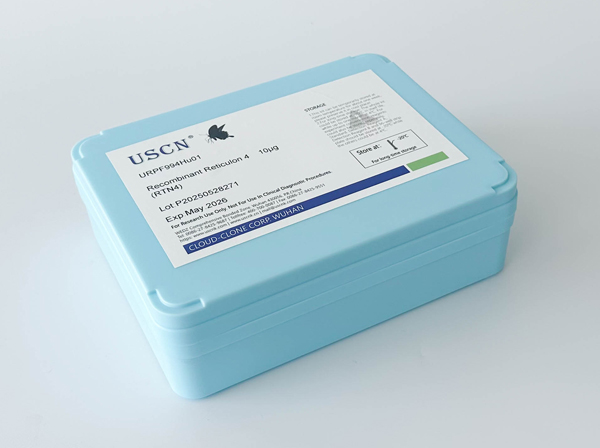Active Cathepsin A (CTSA)
CTS-A; GLB2; GSL; NGBE; PPCA; PPGB; Protective Protein For Beta-Galactosidase; Galactosialidosis; Carboxypeptidase C; Carboxypeptidase L
- Product No.UAPA348Ra01
- Organism SpeciesRattus norvegicus (Rat) Same name, Different species.
- Buffer Formulation20mM Tris, 150mM NaCl, pH8.0, containing 1mM EDTA, 1mM DTT, 0.01% SKL, 5% Trehalose and Proclin300.
- TraitsFreeze-dried powder
- Purity> 90%
- Isoelectric Point7.0
- ApplicationsCell culture; Activity Assays.
- Download Instruction Manual
- UOM 10µg50µg 200µg 1mg 5mg
-
FOB
US$ 166
For more details, please contact local distributors!US$ 414
For more details, please contact local distributors! US$ 828
For more details, please contact local distributors! US$ 2484
For more details, please contact local distributors! US$ 6210
For more details, please contact local distributors!
ACTIVITY TEST of the Active Cathepsin A (CTSA)

Figure. The binding activity of CTSA with NEU.
Cathepsin A (CTSA) is an enzyme that is classified both as a cathepsin and a carboxypeptidase. This gene encodes a glycoprotein that associates with lysosomal enzymes beta-galactosidase and neuraminidase to form a complex of high-molecular-weight multimers. The formation of this complex provides a protective role for stability and activity. It is protective for β-galactosidase and neuraminidase. Besides, Neuraminidase (NEU) has been identified as an interactor of CTSA, thus a binding ELISA assay was conducted to detect the interaction of recombinant rat CTSA and recombinant rat NEU. Briefly, CTSA were diluted serially in PBS, with 0.01% BSA (pH 7.4). Duplicate samples of 100µL were then transferred to NEU-coated microtiter wells and incubated for 2h at 37℃. Wells were washed with PBST and incubated for 1h with anti-CTSA pAb, then aspirated and washed 3 times. After incubation with HRP labelled secondary antibody, wells were aspirated and washed 3 times. With the addition of substrate solution, wells were incubated 15-25 minutes at 37℃. Finally, add 50µL stop solution to the wells and read at 450nm immediately. The binding activity of CTSA and NEU was shown in Figure 1, and this effect was in a dose dependent manner.
USAGE of the Active Cathepsin A (CTSA)
Reconstitute in 20mM Tris, 150mM NaCl (pH8.0) to a concentration of 0.1-1.0 mg/mL. Do not vortex.
STORAGE of the Active Cathepsin A (CTSA)
Avoid repeated freeze/thaw cycles. Store at 2-8°C for one month. Aliquot and store at -80°C for 12 months.
STABILITY of the Active Cathepsin A (CTSA)
The thermal stability is described by the loss rate. The loss rate was determined by accelerated thermal degradation test, that is, incubate the protein at 37°C for 48h, and no obvious degradation and precipitation were observed. The loss rate is less than 5% within the expiration date under appropriate storage condition.
INCREMENT SERVICES
BCA Protein Quantification Kit
Molecular Mass Marker for Protein
Monoclonal Antibody Customized Service
Polyclonal Antibody Customized Service
Protein Activity Test Experiment Service
Electrophoretic Mobility Shift Assay (EMSA) Experiment Service
Buffer
Lentivirus Packaging Experiment Service
Adenovirus Packaging Experiment Service
Real Time PCR Experimental Service
Spike RBD Protein (S-RBD)
Protein G
Protein A
Related products
| Catalog No. | Organism species: Rattus norvegicus (Rat) | Applications (RESEARCH USE ONLY!) |
| UAPA348Ra61 | Active Cathepsin A (CTSA) | Cell culture; Activity Assays. |
| UEPA348Ra61 | Eukaryotic Cathepsin A (CTSA) | Positive Control; Immunogen; SDS-PAGE; WB. |
| UAPA348Ra01 | Active Cathepsin A (CTSA) | Cell culture; Activity Assays. |
| URPA348Ra01 | Recombinant Cathepsin A (CTSA) | Positive Control; Immunogen; SDS-PAGE; WB. |
| UPAA348Ra01 | Polyclonal Antibody to Cathepsin A (CTSA) | IHC |
| ULAA348Ra81 | FITC-Linked Polyclonal Antibody to Cathepsin A (CTSA) | WB; IHC; ICC; IF. |
| ULAA348Ra71 | Biotin-Linked Polyclonal Antibody to Cathepsin A (CTSA) | WB; IHC; ICC. |



